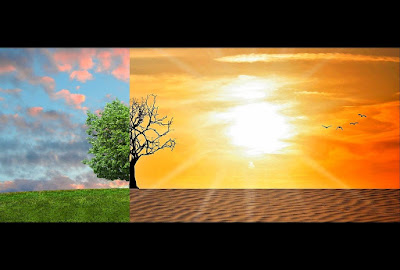Simply put: Xu et al. (2020)
This post is based on the paper "Future of the human climate niche" by Xu et al., published in PNAS.
 |
| Source |
The authors begin by establishing that humans have lived in a preferred temperature band for at least the last 6000 years. This preferred range of temperature has remained constant, irrespective of the fact that much has changed for human societies from the early days of farming, hunting and gathering to today. This is the human climate niche, which has the major band between 11 - 15 ℃ (average 13 ℃) and a secondary band between 20 - 25 ℃. This secondary band corresponds to the region that receives the Indian Monsoon (hence, important!).
Following an RCP8.5 and SSP3 scenario, the results indicate that the areas that experience Mean Annual Temperatures (MAT) of ~13 ℃ (the major band) today will experience MAT of ~ 20 ℃ by the year 2070. For the secondary band, there is a rather alarming result. To quote: "Specifically, 3.5 billion people will be exposed to MAT ≥ 29 ℃, a situation found in the present climate only in 0.8% of the global land surface, mostly concentrated in the Sahara, but in 2070 projected to cover 19% of the global land."
This suggests that Sahara-like conditions could expand from 0.8% of the global land surface today to 19% by the year 2070. 3.5 billion people could experience these almost-uninhabitable living conditions in 50 years.
There are a few important caveats to keep in mind:
 |
| Source: Xu et al. (2020). Black regions have MAT ≥ 29 ℃ today. Shaded regions would have MAT ≥ 29 ℃ by 2070, under the RCP8.5 and SSP3 scenarios and with no migration. Colours show the current MATs. Worrying, isn't it? |
There are a few important caveats to keep in mind:
- This result is based on the RCP8.5 scenario -- which is not a business-as-usual scenario, it is a worst-case scenario. There are reasons to hope that this is not a realistic scenario. [ RCP8.5 means that there will be no mitigation measures. ]
- This result is based on the SSP3 scenario -- which, unfortunately, does seem plausible.
- This result is based on no migration. While we know some migration will take place, we also can not expect it to provide a realistic solution since all countries will be facing this global crisis (thus, who would provide easy asylum?).
Notwithstanding the RCP8.5 caveat, there is an important point there: that while most of the population expansion is taking place at the lower latitudes, climate change is making the preferred temperature niche migrate polewards.
This is particularly important for India. If we try to "dilute" these results to compensate for the RCP8.5 caveat, we could go with one of the following approaches:
- Go with a smaller number than 3.5 billion (the number of people who would live in MAT ≥ 29 ℃ by 2070)
- Go with a smaller number than 29 ℃ (the MAT encountered by about 3.5 billion people by 2070)
- Go with a later year than 2070 (the time we have to prepare 3.5 billion people for almost uninhabitable conditions).
Irrespective of how we attempt this "compensation", the results are ominous for India. Even if we arbitrarily halve the number of people, subtract a whole degree or two from the projected MAT, or add a decade to the countdown, we know a sizeable chunk of our population cannot escape extreme conditions in our own lifetimes. There are two specific factors that make matters specially worse for India: first, that we live in the low-latitude, already-hot regions, and second, that we have a very large population which is still growing. There is no scenario where we can expect a rosy picture for India. (Other scenarios are explored in the Supplementary Information; do see Figure S13.)
The paper also mentions another relevant result -- "Accounting for population growth projected in the SSP3 scenario, each degree of temperature rise above the current baseline roughly corresponds to one billion humans left outside the temperature niche, absent migration."
The authors specifically discourage interpretations regarding migration based on these results alone. This is obvious, considering many other factors play a role in determining migration patterns, and not just temperature.
This is hardly a one-off result. I will be discussing more heat-related results in upcoming posts. The central point remains that humans have a specific niche in the world and we would be well-served to not forget its limits.
---
To subscribe:



lecdisKbist-ra Nick Singh ESET NOD32 Smart Security
ReplyDeleteMcAfee Internet Security
WiFi Analyzer
rapypolhy